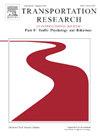Quantifying the effect of road design on urban road driving speed
IF 3.5
2区 工程技术
Q1 PSYCHOLOGY, APPLIED
Transportation Research Part F-Traffic Psychology and Behaviour
Pub Date : 2025-04-15
DOI:10.1016/j.trf.2025.04.005
引用次数: 0
Abstract
Background
Reducing driving speed is a key factor in improving road safety and combating noise emissions. As a result, an increasing number of cities worldwide are lowering speed limits on urban roads. However, main urban roads differ from residential streets in several ways, including their appearance, type of trips they accommodate, mix of vehicles and the presence of public transport. These differences limit the design options available for speed reduction.
This paper examines the impact of continuous road design measures on drivers' preferred speed, safe speed and actual driving speed on urban main roads, as well as the psychological processes influencing these choices.
Methods
A virtual reality (VR) study was conducted using a driving simulator. Participants drove through a series of main roads in VR with varying speed limits and road designs. Speed and lateral position were recorded; in a follow-up survey, participants stated their preferred - as well as the considered ‘safe’ - speed along different road designs. They were also asked about driving style, perceived complexity and safety of each treatment.
Results
Simulator results indicated that only specific road designs result in slightly lower driving speeds. Survey results revealed that certain measures influenced preferred and safe speed. Specifically, those with effectiveness linked to the presence or absence of other road users (cyclists, pedestrians, or other cars). Moreover, the study showed that perceived safety and complexity moderated the effectiveness of these road design measures.
Conclusion
Overall, road design measures investigated in this study provided evidence on the impact of road design on driving behavior, but also demonstrated the need for further investigations to include dynamic human factors, as well as combinations of measures to achieve the goal of lower speeds on urban roads.
量化道路设计对城市道路行驶速度的影响
背景降低车速是改善道路安全和减少噪音排放的关键因素。因此,世界上越来越多的城市正在降低城市道路的速度限制。然而,主要城市道路与住宅街道在几个方面有所不同,包括它们的外观,它们所容纳的旅行类型,车辆组合和公共交通的存在。这些差异限制了减速的设计选择。本文考察了连续道路设计措施对城市主干道上驾驶员首选速度、安全速度和实际行驶速度的影响,以及影响这些选择的心理过程。方法利用驾驶模拟器进行虚拟现实(VR)研究。参与者在VR中驾驶着不同速度限制和道路设计的一系列主要道路。记录速度和侧位;在一项后续调查中,参与者陈述了他们在不同道路设计上的首选速度,以及他们认为的“安全”速度。他们还被问及驾驶风格、感知到的复杂性和每种治疗的安全性。结果模拟器结果表明,只有特定的道路设计才会导致行车速度略有降低。调查结果显示,某些措施会影响首选和安全速度。具体来说,那些与其他道路使用者(骑自行车的人、行人或其他车辆)的存在与否有关的有效性。此外,研究表明,感知安全性和复杂性调节了这些道路设计措施的有效性。总体而言,本研究调查的道路设计措施为道路设计对驾驶行为的影响提供了证据,但也表明需要进一步调查,包括动态人为因素,以及措施的组合,以实现城市道路上的低速度目标。
本文章由计算机程序翻译,如有差异,请以英文原文为准。
求助全文
约1分钟内获得全文
求助全文
来源期刊
CiteScore
7.60
自引率
14.60%
发文量
239
审稿时长
71 days
期刊介绍:
Transportation Research Part F: Traffic Psychology and Behaviour focuses on the behavioural and psychological aspects of traffic and transport. The aim of the journal is to enhance theory development, improve the quality of empirical studies and to stimulate the application of research findings in practice. TRF provides a focus and a means of communication for the considerable amount of research activities that are now being carried out in this field. The journal provides a forum for transportation researchers, psychologists, ergonomists, engineers and policy-makers with an interest in traffic and transport psychology.

 求助内容:
求助内容: 应助结果提醒方式:
应助结果提醒方式:


